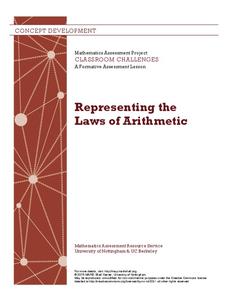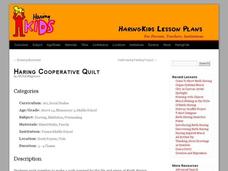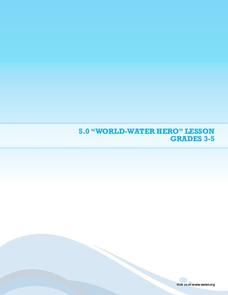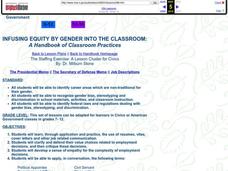Mathematics Assessment Project
Representing Quadratic Functions Graphically
Sometimes being different is an advantage. An engaging activity has scholars match cards with quadratic functions in various forms. Along the way, they learn about how each form highlights key features of quadratic functions.
Mathematics Assessment Project
Designing 3d Products: Candy Cartons
Wouldn't it be great to work in a candy factory? Learners get their chance as they first design a carton for a candy that meets certain requirements. They then examine and analyze nets and explanations in sample student responses.
Mathematics Assessment Project
Representing the Laws of Arithmetic
Sixth graders connect numerical expressions to geometric area. They first complete an assessment task requiring them to identify area models for numerical expressions. Learners then participate in an activity to match area models to...
Mathematics Assessment Project
Classifying Proportion and Non-Proportion Situations
Proportions, proportions, everywhere. Class members complete an assessment task solving problems involving proportionality. They then complete an activity classifying given situations as proportional or non-proportional.
Mathematics Assessment Project
Solving Quadratic Equations
Scholars first complete an individual assignment using a quadratic equation to model the movement of a bus around a corner. Learners then discuss their solutions with classmates and analyze the provided sample responses.
Mathematics Assessment Project
Modeling Motion: Rolling Cups
Connect the size of a rolling cup to the size of circle it makes. Pupils view videos of cups of different sizes rolling in a circle. Using the videos and additional data, they attempt to determine a relationship between cup...
Howard County Schools
Factoring Trinomials Using Tiles
What's the opposite of multiplying binomials? Learners apply their previous knowledge of multiplying binomials using algebra tiles to factor trinomials. The activity introduces factoring as a process that uses algebra tiles to...
Curated OER
Was the Iraq War a "Humanitarian Intervention?"
Learners debate the intent of the Iraq war. For this humanitarian intervention lesson, students each research a view point and defend it in a class room debate. Learners defend the views points of Terry...
Curated OER
Haring Cooperative Quilt
Students inspect visual arts by examining images on the web. In this art history instructional activity, students discuss the history of art after researching Keith Haring's work on the Internet. Students analyze...
Curated OER
Satire in Fiction
Twelfth graders identify satire in various fictional texts. In this language arts lesson, 12th graders will learn to define satire, parody, and caricature. Students will identify different forms of satire in historical and...
Curated OER
World-Water Hero
Students make up a superhero. In this water quality instructional activity, students create a superhero with super powers that can improve water quality and availability.
Curated OER
You Can Stop!!
Students analyze smoking behavior based on peer pressure. In this health lesson, students read and complete worksheets on the internet concerning the behaviors associated with smoking. They summarize what they have learned by...
Curated OER
Night by Elie Weisel
Students read "No News from Auschwitz" and answer the study questions as an introduction to the novel. They record reactions to the essay and compare with reactions after reading "Night".
Curated OER
I Hear Poetry
Students practice analysis of poetry by analyzing song lyrics using a worksheet to guide the analysis process. They work in small groups to assess the stylistic and literary devices used in the song lyrics then they find a published...
Curated OER
Making a Speech
Fourth graders make a five minute speech on the life of a famous person.
Curated OER
The Great Gatsby
Eleventh graders investigate the concept of the American Dream. They use the novel "The Great Gatsby" as an example from literature. Students brainstorm in order to define the American Dream.
Curated OER
Conventions and Proofreading
Students explore and apply their proofreading skills in order to prepare their project essays for peer editing and final drafting. They refine their final project essays by identifying and correcting spelling and grammatical errors.
Curated OER
Pythagorean Theorem
Students explore how the Pythagorean Theorem works and how to apply it.
Curated OER
Can You Hear Me Now?
Learners demonstrate their ability to give and follow verbal directions. They explain steps to guide another student to reproduce a drawing, and evaluate their partner's articulation abilities.
Curated OER
The Staffing Exercise: A Lesson Cluster for Civics
Students discuss gender bias and non-traditional career areas as they relate to governmental appointed positions. The participate in a simulation in which they apply for and decide who would get traditionally male positions in the Dept....
Curated OER
Pythagorean Theorem
Students are introduced to the Pythagorean theorem. They use three different activities that give students the opportuntiy to observe triangles, and use the Pythagorean theorem and practice different ways of determining areas of...
Curated OER
Shine and Reflect
Seventh graders complete a presentation and present it to the class. In this shine and reflect lesson students give their presentation then view their video taped presentation.
Curated OER
Infusing Equity by Gender into the classroom
Students examine equality. In this civics lesson, students appoint committees for various offices then model a mock committee/application process in the classroom, followed by a discussion of whether equity was achieved or not and why.
Curated OER
Recuerdos De Mis Vacaciones Mexicanas.
Students are presented with five items found in a suitcase to reflect upon the experience of a Mexican vacation. They use realia to produce a journal entry about one of the objects and its uses. The item is then brought to the front of...























